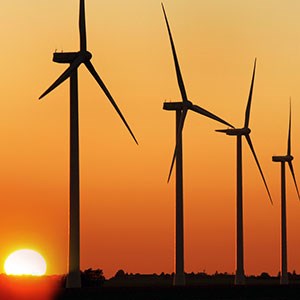
Onshore wind turbines have unique natural, cultural and historical resource impacts. While there are some concerns with potential habitat loss, land conversion, transmission infrastructure, and artificial light, the key impacts of onshore wind turbines include noise, turbine strikes, and visual impacts.
Noise: Turbine blades operating at normal speeds can generate noise beyond ambient background levels and interrupt natural soundscapes, which may reduce bird nesting, breeding, population density, and cause behavioral disturbances.
Turbine Strikes: This refers to the collision or barotrauma (physical damage to body tissue from changes in air pressure) that birds or bats may experience from wind turbines. The frequency of bird and bat collisions may differ depending on the type of bird/bat, weather conditions, and site characteristics.
Visual Impacts: The height of wind turbines, which can be hundreds of feet tall, can decrease the value of natural viewsheds, particularly in areas of recreational, historical, cultural, or archaeological importance. Aviation lighting placed on top of turbines may also impact the natural lightscape and dark night skies of the area. Wind Farms typically cover thousands of acres of land and each turbine is connected by a road for construction and maintenance purposes. This network of roads can scar the area and adversely affect a visitor's visual experience.
Other Impacts: Impacts from construction and development activities, such as the construction of power lines and fugitive dust events, may also affect park resources.
For more information on potential resource impacts of onshore wind energy technologies, please reference the Wind Energy Development Programmatic Environmental Impact Statement Information Center or visit the links below.
Related Resources
- Energy 101: Wind Turbines, U.S. Department of Energy
- Great Plains Wind Energy Habitat Conservation Plan (final document anticipated in 2015) [825 KB PDF]
Last updated: October 17, 2016
